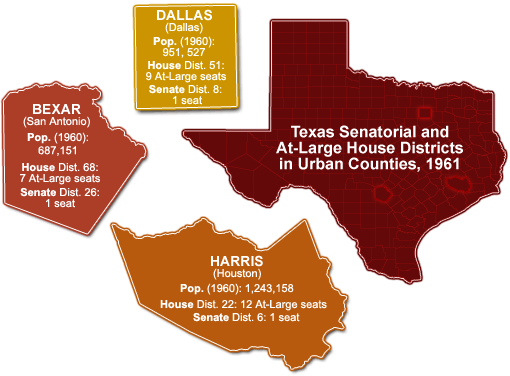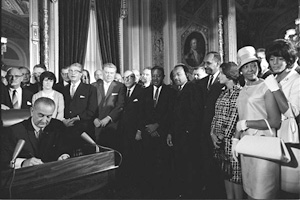|
|
||
 |
||
|
If representation in the Texas Legislature had been proportional to population after redistricting in 1961, each of the 31 state senators and each of the 150 state representatives should have represented 309,022 and 63,865 Texans respectively. But, since the state's Constitution said that no county could have more than one senator, senators from the largest urban counties – almost always non-latino white men – represented hundreds of thousands more than the ideal, including large minority populations. Similarly, state representatives from the largest urban counties represented tens of thousands more than the ideal. They too were almost always white because they were selected county-wide in at-large elections. The Legislature, dominated by white men from rural counties, had drawn the districts that way. By the mid-1960s the federal courts and the Congress had made it ever more difficult to exclude African-Americans and other minorities from the electoral and representational systems. A key component of this push to ensure the civil rights of minorities in the electoral arena was new restrictions on legislative and congressional redistricting. These restrictions were shaped by a combination of court decisions and federal legislation at the heart of civil rights reform in the United States. In Baker v. Carr (1962) the U.S. Supreme Court ruled that it was within its jurisdiction to ensure fairness in state redistricting laws and procedures. In essence, it could indeed intervene in state redistricting processes if necessary. This was the cornerstone decision for federal court intervention in this area. Later, in Reynolds v. Sims (1964) the Supreme Court ruled that the seats in state legislatures must be apportioned on the basis of population. This case articulated most clearly the "one person, one vote" principle that requires legislative districts to contain equal populations. We take for granted that this principle is guaranteed by the U.S. Constitution. But until this decision, state redistricting plans – in Texas as well as other states – were frequently designed to include more people in minority dominated districts than in white dominated districts.  Johnson signs the Voting Rights Act in the Capitol Rotunda as civil rights leaders look on, August 6, 1965, Washington, D.C. Johnson signs the Voting Rights Act in the Capitol Rotunda as civil rights leaders look on, August 6, 1965, Washington, D.C. After signing the Voting Rights Act, Johnson extends his hand to Dr. Martin Luther King, August 6, 1965, Washington, D.C. After signing the Voting Rights Act, Johnson extends his hand to Dr. Martin Luther King, August 6, 1965, Washington, D.C.Congress subsequently passed the Voting Rights Act of 1965 (VRA) . The most prominent provisions of this act prohibited literacy tests for voters (Texas did not use them) and residency requirements of more than thirty days – both of which were widely used in the South to prevent black voting. The drawing of district lines was affected by two additional provisions in the VRA that reinforced the Supreme Court decisions in Baker v. Carr and Reynolds v. Sims. Section 2 restates the constitutional principle that no person can be denied the right to vote based on race, color or previous condition of servitude. Section 5 contains a temporary provision that "covered jurisdictions" must submit any voting changes (including redistricting plans) to the U.S. Attorney General and the Department of Justice for review. The covered jurisdictions specified in the VRA were:
The Department of Justice was charged with determining whether the proposed changes diluted or weakened the voting strength of minorities. If so, the Justice Department was empowered to refuse to approve (or in the frequently used language of the legislation, "preclear") the changes. The VRA's Section 5 was originally written to expire after five years – a result of legislative compromise to get enough votes for the bill. Section 5 was extended for five years in 1970 and for seven years in 1975. In 1982, a bill to extend Section 5 for 25 years (until 2007) became law. (See the U.S. Department of Justice website for more background on the Voting Rights Act.) Whether or not the VRA is allowed to expire depends on the Congressional approval, but the core rulings in Baker v. Carr and Reynolds v. Sims recognizing the role of the federal courts and the principle of one-person, one-vote, will remain in place unless they are overturned by the U.S. Supreme Court. |
||
| Source: Photos are by Yoichi R. Okamoto from the LBJ Library collection. (full source) | ||